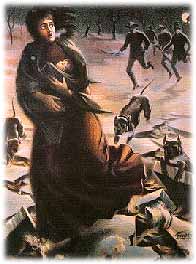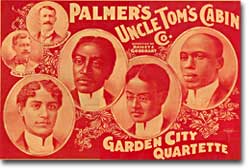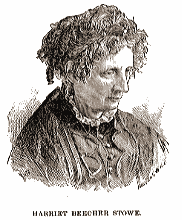28d. Harriet Beecher Stowe — Uncle Tom's Cabin

"So you're the little woman who wrote the book that made this great war."
This was Abraham Lincoln's reported greeting to Harriet Beecher Stowe when he met her ten years after her book Uncle Tom's Cabin was published. Although the President may have been exaggerating a bit, few novels in American history have grabbed the public spotlight and caused as great an uproar as Uncle Tom's Cabin.
Across the north, readers became acutely aware of the horrors of slavery on a far more personal level than ever before. In the south the book was met with outrage and branded an irresponsible book of distortions and overstatements. In such an explosive environment, her story greatly furthered the Abolitionist cause north of the Mason-Dixon Line and promoted sheer indignation in plantation America.
 Stage plays and movies were made of the controversial abolitionist novel, Uncle Tom's Cabin, although most of the characters were played by white actors and many of the characters became stereotypical caricatures.
Stage plays and movies were made of the controversial abolitionist novel, Uncle Tom's Cabin, although most of the characters were played by white actors and many of the characters became stereotypical caricatures.Harriet Beecher Stowe was born into a prominent family of preachers. Her father, Lyman Beecher, was one of the most renowned ministers in his generation. Her brother Henry Ward Beecher was already an outspoken Abolitionist, and by the mid 1850s would become the driving force behind aiding the Free-Soil cause in "bleeding Kansas" (not permitting slavery in the new territory). While living for a short while in Cincinnati, Stowe became exposed to actual runaway slaves. Her heart ached at the wretched tales she heard. She began to write a series of short stories depicting the plight of plantation slaves.
Encouraged by her sister-in-law, Stowe decided to pen a novel. First published as a series in 1851, it first appeared as a book the following year. The heart-wrenching tale portrays slave families forced to cope with separation by masters through sale. Uncle Tom mourns for the family he was forced to leave. In one heroic scene, Eliza makes a daring dash across the frozen Ohio River to prevent the sale of her son by slave traders. The novel also takes the perspective that slavery brings out the worst in the white masters, leading them to perpetrate moral atrocities they would otherwise never commit.

Harriet Beecher Stowe lost a child in infancy, an experience that she said made her empathize with the losses suffered by slave mothers whose children were sold.
The reaction was incredible. Uncle Tom's Cabin sold 300,000 copies in the North alone. The Fugitive Slave Law, passed in 1850, could hardly be enforced by any of Stowe's readers. Although banned in most of the south, it served as another log on the growing fire.
The book sold even more copies in Great Britain than in the United States. This had an immeasurable appeal in swaying British public opinion. Many members of the British Parliament relished the idea of a divided United States. Ten years after the publication of Uncle Tom's Cabin, the British people made it difficult for its government to support the Confederacy, even though there were strong economic ties to the South. In the end, Mr. Lincoln may not have been stretching the truth after all.






